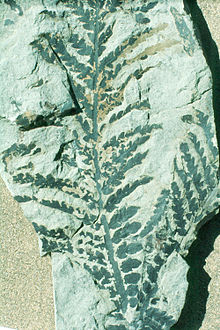| Dicroidium zuberi Temporal range:
| |
|---|---|

| |
| Dicroidium zuberi leaf from the Early Triassic Gosford Formation of Terrigal, NSW, Australia. | |
| Scientific classification | |
| Kingdom: | Plantae |
| Clade: | Tracheophytes |
| Order: | †Corystospermales |
| Family: | †Corystospermaceae |
| Genus: | †Dicroidium |
| Species: | †D. zuberi
|
| Binomial name | |
| †Dicroidium zuberi Holmes and Ash 1979
| |
Dicroidium zuberi is a large bipinnate species of the seed fern Dicroidium with a forked rachis. The leaves are affiliated with Umkomasia feistmantellii megasporophylls and Petruchus barrealensis microsporophylls.[1][2]
D. zuberi was a common species in the coeval vegetation of the Sydney and Lorne Basins of New South Wales. Specimens have been found near Wairaki Hut and indicate that this species may have been as common in Scytho-Anisian vegetation of coastal New Zealand. In younger rocks younger than the late Anisian, they are outnumbered by unipinnate Dicroidium leaves such as those belonging to D. odontopteroides.[2]
- ^ Anderson, Heidi M.; Barbacka, Maria; Bamford, Marion K.; Holmes, W. B. Keith; Anderson, John M. (2020-01-02). "Dicroidium (foliage) and affiliated wood Part 3 of a reassessment of Gondwana Triassic plant genera and a reclassification of some previously attributed". Alcheringa: An Australasian Journal of Palaeontology. 44 (1): 64–92. doi:10.1080/03115518.2019.1622779. ISSN 0311-5518. S2CID 199109037.
- ^ a b Retallack, Greg J. (1977). "Reconstructing Triassic vegetation of eastern Australasia: a new approach for the biostratigraphy of Gondwanaland". Alcheringa: An Australasian Journal of Palaeontology. 1 (3): 247–278. doi:10.1080/03115517708527763. ISSN 0311-5518.